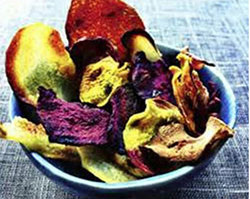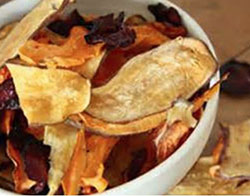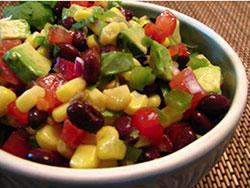Making Fresh Salsa and Chips with Kids – a fun way to serve vegetables!
Gisele Jefferson, Family & Consumer Science Extension Agent, Golden Plains Area

Vegetables provide a variety of vitamins, minerals, and fiber that give us many health benefits. They help us grow and maintain strong and healthy bodies. They also help us fight off infections and chronic disease, and reduce our risk of obesity, heart disease, diabetes and cancer.
Most vegetables are naturally low in fat and calories. None have cholesterol. They are important sources of many nutrients, including potassium, dietary fiber, folate (folic acid), vitamin A and vitamin C.
Benefits of Eating Vegetables:
- Potassium helps to maintain healthy blood pressure. Vegetable sources of potassium include sweet potatoes, white potatoes, white beans, tomato products (paste, sauce, and juice), beet greens, soybeans, lima beans, spinach, lentils and kidney beans.
- Fiber from vegetables helps reduce blood cholesterol levels and may lower the risk of heart disease. Fiber helps reduce constipation and diverticulosis. Fiber-containing foods such as vegetables help you feel full with fewer calories.
- Folate helps the body form red blood cells. Women of childbearing age, who may become pregnant, may need extra folate from foods, in addition to the amount contained in pre-natal vitamins. This reduces the risk of serious developmental problems to the baby during pregnancy. Good vegetable sources of folate are dark green leafy vegetables like spinach, kale and Brussels sprouts.
- Vitamin A keeps eyes and skin healthy and helps to protect against infections. Vegetables that provide a good source of vitamin A include leafy greens, pumpkin, squash, carrots, broccoli, red peppers and other orange and yellow vegetables.
- Vitamin C helps heal cuts and wounds and keeps teeth and gums healthy. Vitamin C aids in iron absorption. Vegetables that are packed with vitamin C include red and green peppers, broccoli, Brussels sprouts, cabbage, cauliflower, tomatoes and potatoes.
Vegetables are a vital part of a healthy diet for people of all ages. Everyone should eat three or more servings per day. It is also important to eat vegetables that are different colors and from different groups: dark-green vegetables, starchy vegetables, red and orange vegetables, beans and peas, and other vegetables.
Many families struggle to get their children to eat enough vegetables. It may take several times serving new foods to get kids or adults to try them. Sometimes it helps to include a new food into a family favorite recipe.
Who doesn’t like chips and dip? They are tasty and fun to eat. You can make salsa and chips out of a wide variety of vegetables and fruits. So, let’s make them a healthy addition to your family meals and snacks.
Let’s Talk
Start a discussion about vegetables with children by comparing their many shapes, colors and sizes. “What different colored vegetables do you like to eat?” Talk about how vegetables help our bodies grow strong and healthy, because they have lots of vitamins, minerals and fiber. Show children they are fun to eat by trying some new vegetables and new recipes. You can grow some vegetables in your own backyard garden or buy them at a Farmers’ Market! Ask children, “How many different vegetables can you name?”
Recipes for Health

Baked Veggie Chips
1 fresh beet
1 medium potato or sweet potato
1 medium zucchini or yellow summer squash
1 medium parsnip or carrot
2 tablespoons canola or olive oil
2 tablespoons grated Parmesan cheese, optional
½ teaspoon salt
½ teaspoon garlic powder
½ teaspoon dried oregano
Dash black pepper
Wash and peel vegetables. Cut into 1/8-inch slices using a mandoline or handheld slicer, or sharp knife. Place in a large bowl. Drizzle with oil.
Combine the remaining ingredients; sprinkle over the vegetables and stir to coat all the slices.
Arrange in a single layer on two ungreased 15 x 10-inch baking sheets. Using parchment paper liner on the baking sheets makes for an easy clean up.
Bake at 375 degrees Fahrenheit for 15-20 minutes or until golden brown and crisp, turning once with a spatula. Cool and serve. Store in an air-tight container.
Makes 7 servings.
Nutritional Facts: ½ cup equals 108 calories, 5 g fat, 1 mg cholesterol, 220 mg sodium, 15 g carbohydrate, 2 g fiber, 2 g protein.
Recipe adapted from: www.tasteofhome.com

Corn & Bean Salsa
1 ½ cups fresh corn kernels, cooked; or canned/frozen corn
1 can black beans, rinsed and drained
1 red or green bell pepper, chopped
1 avocado, chopped
1 fresh tomato, diced or 8-10 cherry tomatoes cut in quarters
½ cup finely chopped red onions or fresh green onions
2 tablespoons apple cider vinegar mixed with 2 tablespooons olive oil – or ¼ cup Italian salad dressing
Optional ingredients:
¼ teaspoon each of salt and black pepper
¼ cup chopped fresh cilantro or parsley
½ teaspoon hot pepper sauce
1 jalapeno pepper, seeded and diced
1 clove garlic, finely diced or sprinkle of garlic powder
Combine all ingredients into a large bowl. Chill in refrigerator until ready to serve.
Serve with corn chips or vegetable chips.
Makes 10 servings
Nutritional Facts: ½ cup serving equals 79 calories, 2.5 g protein, 3.8 g fat, 9.8 g carbohydrate, 3.3 g fiber, 40 mg sodium, .6 g saturated fat, 0 g cholesterol





